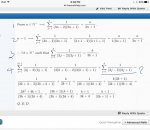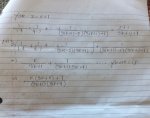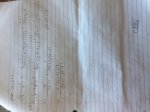You are using an out of date browser. It may not display this or other websites correctly.
You should upgrade or use an alternative browser.
You should upgrade or use an alternative browser.
Complicated Induction problem: sum[j=1,n][1/((3n-2)(3x+1)) = 1/(3n+1)
- Thread starter Tayeeba
- Start date
Prove \(\displaystyle \displaystyle n \in \mathbb N^+ \implies \sum_{j=1}^n\dfrac{1}{(3n - 2)(3n + 1)} = \dfrac{n}{3n + 1}.\)
\(\displaystyle \displaystyle n = 1 \implies \sum_{j=1}^n\dfrac{1}{(3n - 2)(3n + 1)} = \dfrac{1}{(3 * 1 - 2)(3 * 1 + 1)} = \dfrac{n}{1(3n + 1)} = \dfrac{n}{3n + 1}.\)
\(\displaystyle \therefore \exists\ k \in \mathbb N^+\ such\ that\ \displaystyle \sum_{j=1}^k \dfrac{1}{(3j - 2)(3j + 1)} = \dfrac{k}{3k + 1}.\)
\(\displaystyle \displaystyle \sum_{j=1}^{k+1}\dfrac{1}{(3j - 2)(3j + 1)} = \dfrac{1}{(3(k + 1) - 2)(3(k + 1) + 1)} + \sum_{j=1}^k \dfrac{1}{(3j - 2)(3j + 1)} = \)
\(\displaystyle \dfrac{1}{(3k + 3 - 2)(3k + 3 + 1)} + \dfrac{k}{3k + 1} = \dfrac{1}{(3k + 1)(3k + 4)} + \dfrac{k(3k + 4)}{(3k + 1)(3k + 4)} = \)
\(\displaystyle \dfrac{3k^2 + 4k + 1}{(3k + 1)(3k + 4)} = \dfrac{(3k + 1)(k + 1)}{(3k + 1)(3k + 4)} = \dfrac{k + 1}{3k + 4} = \dfrac{k + 1}{3(k + 1) + 1}.\)
\(\displaystyle Q.E.D.\)
\(\displaystyle \displaystyle n = 1 \implies \sum_{j=1}^n\dfrac{1}{(3n - 2)(3n + 1)} = \dfrac{1}{(3 * 1 - 2)(3 * 1 + 1)} = \dfrac{n}{1(3n + 1)} = \dfrac{n}{3n + 1}.\)
\(\displaystyle \therefore \exists\ k \in \mathbb N^+\ such\ that\ \displaystyle \sum_{j=1}^k \dfrac{1}{(3j - 2)(3j + 1)} = \dfrac{k}{3k + 1}.\)
\(\displaystyle \displaystyle \sum_{j=1}^{k+1}\dfrac{1}{(3j - 2)(3j + 1)} = \dfrac{1}{(3(k + 1) - 2)(3(k + 1) + 1)} + \sum_{j=1}^k \dfrac{1}{(3j - 2)(3j + 1)} = \)
\(\displaystyle \dfrac{1}{(3k + 3 - 2)(3k + 3 + 1)} + \dfrac{k}{3k + 1} = \dfrac{1}{(3k + 1)(3k + 4)} + \dfrac{k(3k + 4)}{(3k + 1)(3k + 4)} = \)
\(\displaystyle \dfrac{3k^2 + 4k + 1}{(3k + 1)(3k + 4)} = \dfrac{(3k + 1)(k + 1)}{(3k + 1)(3k + 4)} = \dfrac{k + 1}{3k + 4} = \dfrac{k + 1}{3(k + 1) + 1}.\)
\(\displaystyle Q.E.D.\)
Prove \(\displaystyle \displaystyle n \in \mathbb N^+ \implies \sum_{j=1}^n\dfrac{1}{(3n - 2)(3n + 1)} = \dfrac{n}{3n + 1}.\)
\(\displaystyle \displaystyle n = 1 \implies \sum_{j=1}^n\dfrac{1}{(3n - 2)(3n + 1)} = \dfrac{1}{(3 * 1 - 2)(3 * 1 + 1)} = \dfrac{n}{1(3n + 1)} = \dfrac{n}{3n + 1}.\)
\(\displaystyle \therefore \exists\ k \in \mathbb N^+\ such\ that\ \displaystyle \sum_{j=1}^k \dfrac{1}{(3j - 2)(3j + 1)} = \dfrac{k}{3k + 1}.\)
\(\displaystyle \displaystyle \sum_{j=1}^{k+1}\dfrac{1}{(3j - 2)(3j + 1)} = \dfrac{1}{(3(k + 1) - 2)(3(k + 1) + 1)} + \sum_{j=1}^k \dfrac{1}{(3j - 2)(3j + 1)} = \)
\(\displaystyle \dfrac{1}{(3k + 3 - 2)(3k + 3 + 1)} + \dfrac{k}{3k + 1} = \dfrac{1}{(3k + 1)(3k + 4)} + \dfrac{k(3k + 4)}{(3k + 1)(3k + 4)} = \)
\(\displaystyle \dfrac{3k^2 + 4k + 1}{(3k + 1)(3k + 4)} = \dfrac{(3k + 1)(k + 1)}{(3k + 1)(3k + 4)} = \dfrac{k + 1}{3k + 4} = \dfrac{k + 1}{3(k + 1) + 1}.\)
\(\displaystyle Q.E.D.\)

Thank you so much. One more help please. In 4th line I haven't understood the underlined portion. From where dies it come from please?
In many proofs by induction you are to prove that
\(\displaystyle \displaystyle \sum_{j=1}^nf(j) = g(n),\ where\ n \in \mathbb N^+.\)
So you prove \(\displaystyle f(1) = g(1).\)
That is frequently easy. And it shows that there is at least some positive integer k such that
the sum of f(1) + ... f(k) = g(k).
Now let's consider
\(\displaystyle f(1) + ... f(k) + f(k + 1) = \{f(1) + ... f(k)\} + f(k + 1) = g(k) + f(k + 1)\)
All that remains is to show that \(\displaystyle g(k) + f(k + 1) = g(k + 1).\)
You can do the same trick with products as well.
\(\displaystyle \displaystyle \prod_{j=1}^k f(j) = g(k) \implies \prod_{j=1}^{k+1}f(j) = f(k + 1) * \prod_{j=1}^kf(j) = f(k + 1) * g(k).\)
Now you prove \(\displaystyle f(k + 1) * g(k) = g(k + 1).\)
\(\displaystyle \displaystyle \sum_{j=1}^nf(j) = g(n),\ where\ n \in \mathbb N^+.\)
So you prove \(\displaystyle f(1) = g(1).\)
That is frequently easy. And it shows that there is at least some positive integer k such that
the sum of f(1) + ... f(k) = g(k).
Now let's consider
\(\displaystyle f(1) + ... f(k) + f(k + 1) = \{f(1) + ... f(k)\} + f(k + 1) = g(k) + f(k + 1)\)
All that remains is to show that \(\displaystyle g(k) + f(k + 1) = g(k + 1).\)
You can do the same trick with products as well.
\(\displaystyle \displaystyle \prod_{j=1}^k f(j) = g(k) \implies \prod_{j=1}^{k+1}f(j) = f(k + 1) * \prod_{j=1}^kf(j) = f(k + 1) * g(k).\)
Now you prove \(\displaystyle f(k + 1) * g(k) = g(k + 1).\)
Last edited:
In many proofs by induction you are to prove that
\(\displaystyle \displaystyle \sum_{j=1}^nf(j) = g(n),\ where\ n \in \mathbb N^+.\)
So you prove \(\displaystyle f(1) = g(1).\)
That is frequently easy. And it shows that there is at least some positive integer k such that
the sum of f(1) + ... f(k) = g(k).
Now let's consider
\(\displaystyle f(1) + ... f(k) + f(k + 1) = \{f(1) + ... f(k)\} + f(k + 1) = g(k) + f(k + 1)\)
All that remains is to show that \(\displaystyle g(k) + f(k + 1) = g(k + 1).\)
You can do the same trick with products as well.
\(\displaystyle \displaystyle \prod_{j=1}^k f(j) = g(k) \implies \prod_{j=1}^{k+1}f(j) = f(k + 1) * \prod_{j=1}^kf(j) = f(k + 1) * g(k).\)
Now you prove \(\displaystyle f(k + 1) * g(k) = g(k + 1).\)
thanks! awesome! Thank you so much for helping me out.



